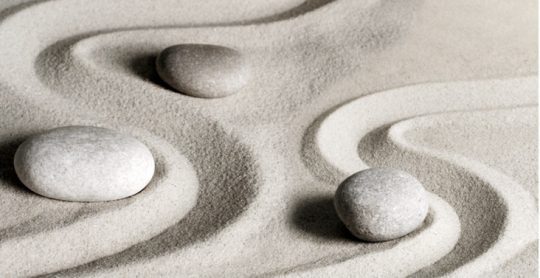
“Peace and love create more peace and love,” says Teacher Wei. “Suffering and conflict create more suffering and conflict.” If we want more peace and love, but our hearts carry frustration, fear, or worry, we cannot truly create them from that state. And if our intentions are too strong — “I want to create more peace and love!” — this can block them. No matter how much we try to reduce suffering in our health, relationships, and the world, the information we carry in our hearts is the essence of what we create. We must become peace and love.
So, what is the key to this transformation?
Harmony.
What is Harmony?
In Mingjue Gongfu and Zhineng Qigong, harmony is a state of being characterized by a steady, organized, and ordered flow of information and qi (energy). “It is a very beautiful state,” says Teacher Wei, “with a very regular and stable rhythm.” When we observe the beauty of nature or listen to sweet-sounding music, the harmony we feel is from the quality of their rhythms and vibrations. They carry good information and qi to merge with our bodies and consciousness.
Harmony is a physiological state that can be measured by technologies. In a state of harmony, the heart’s electrical signals generate smooth and regular wave patterns. The brain waves, too. In a state of disharmony, the brain and heart waves become jagged and irregular. If the body’s state isn’t harmonious, this can affect consciousness, and vice versa. While disharmony begets disharmony, harmony also begets harmony.
A state of harmony enhances health. If the cells of the body are bathed in a harmonious qi and information field, they become strong and function well. If the field is disordered or chaotic, the cells cannot function effectively or efficiently, and eventually, imbalances in health can develop. For the internal organs, it is the same, so this rhythm also affects your emotions. So when the information order in the body becomes clear, and the cells and organs function optimally, all kinds of health imbalances and conditions can disappear.
Love your body by harmonizing your state. Release any fixations about your body, and allow the peaceful information to flow.
How to Cultivate More Harmony
Harmony is something you can choose. In daily life, you are always merging and transforming with your environment. So you can pause and choose more harmonizing information — joyful people, time in nature, a simpler home, and the daily information you read and watch, like the news, videos, and social media. This good information will hunhua (merge and transform) with the information of your body and consciousness. If your mingjue (consciousness) still needs to stabilize and strengthen, a harmonious external environment can really help to support this process.
Harmony is also something you can create. This is a more independent way of life. Here’s how:
1. Begin to “see through” the patterns of disharmony. Observe your thoughts, emotions, and relationships. You can observe your attachments to and fixations on the material world — for example, life stories, identities, relationships, and specific outcomes for health or society.
2. Observe your lifestyle choices. What you eat or how you sleep is information you are sending to your body. Anything that generates attachments or fixations will create disharmony. The simple act of observing without judgment or labels can begin the process of transforming them.
3. Come to the clear mingjue state. Consciousness is in the present moment and free of attachments. The mingjue state is the state of I am. So you know, I am harmony. The harmony that is mingjue can merge with the whole body, infusing all the cells with this high-level harmony. This can mobilize your body’s qi. It is a way to heal your consciousness and your whole body at the same time.
4. Breathing methods, sound practices, and body movements can all mobilize bodily qi and create harmony in your body. Practicing them in the mingjue state can amplify their effects.
Personal Harmony Benefits Others (Daode Practice)
As your mingjue becomes stronger and more stable, and you have practiced creating more harmony within, you can move more freely in different environments and connect with different kinds of people. If there is inharmonious information, it cannot influence you in a negative way; it can, in fact, be a way to further train the stability and strength of your mingjue.
The vibrations of your consciousness and the information in your heart can influence others and harmonize them. “Share your beautiful harmonious experiences and behavior with others,” says Teacher Wei. “When people see your face or your eyes, they immediately feel your harmony, your peace, your happiness. Your face and your eyes immediately give good, harmonious information.” Your internal state, and that of others, can improve collectively. These ripples of good information and qi can activate universal love.
Benefit self, benefit the world.
As mingjue practitioners, this is what we practice. Mingjue Gongfu is a series of methods to cultivate more harmony and stabilize this state. Even if there is a lot of suffering or conflict around us, our hearts remain open and free-flowing. Nothing can block the harmony of our hearts. This high-level state of being and doing was the vision of Dr. Pang Ming, the founder of Zhineng Qigong: “When human wisdom and ability develops enough, a super harmonious world will appear…and all humans will become one harmonious big family.”
Q&A with Teacher Wei
Course participant: “I have been trying to keep harmony in my small family for years, but it hasn’t worked. My family does not cooperate and it feels toxic. I am exhausted by doing so. I feel like I can’t do it any more. I feel so powerless.”
Teacher Wei: “First, practice mingjue love to create inner harmony. This is a harmony that is independent from external conditions. Once that is more stable, then expand this harmony, starting from within. Do not go and try to make harmony with others before you have arrived at a stable and peaceful mingjue state.”
Harmony always begins with ourselves.
DAILY PRACTICE FOR INNER HARMONY: THROAT BREATHING
Why this practice?
Throat Breathing is rougher and coarser than regular breathing, so it has the potential to stabilize and focus consciousness, induce calm, draw qi into lower dantian to strengthen vitality, and to harmonize internal qi.
Variations: You can practice with stronger or gentler breathing, depending on what feels right to you in the moment. You can also practice Throat Breathing while sitting, standing, or lying down. It is common to feel “asleep but not asleep” with this practice.
Practice:
First, come to a good mingjue state by practicing the “n sound” for a few minutes (click here for an 8-minute guided practice by Teacher Wei). Feel your consciousness becoming very pure and clear, independent from everything yet merged with everything.
Bring a gentle smile to your face, feeling your lips extend from ear to ear. Make your throat rounded, like there is a qi ball inside it.
Breathe in, keeping your throat open and rounded, as though the qi ball is expanding within. Feel the coarse vibrations in your throat.
Breathe out, keeping the throat open and rounded. Feel the coarse vibrations in your throat.
Continue this pattern, but expanding the in-breath deeply into the middle dantian (chest) and lower dantian (abdomen) — like balloons inflating in each cavity. The breathing is full. The entire inner space expands.
Continue to feel the qi movement in the middle and lower dantian spaces, and in the whole body. You may feel the energy rise along both sides of your face (along the outer edges of the eyes), in your brain, and in upper dantian (center of the head).
This breathing goes from the middle channel down to the inner spaces of the three dantians — the qi of upper, middle, and lower dantian is all harmonized as one.
The throat remains open and expanded like a big qi channel.
When you are finished, hold a qi ball in your palms in front of duqi (the navel).
Slowly raise the qi ball up in front of you, to above the head. Turn palms down toward baihui (the crown of the head), then slowly lower palms, pouring qi down through the head, neck, chest, and abdomen. Place palms on duqi.
Rest a while there.
Always hold this in mind: Who is breathing and who is observing the breath?
Reflection Question:
When you’re feeling disordered and inharmonious within, what are some other methods besides Throat Breathing, or other lifestyle actions, that can help you open your heart and harmonize the field?
DEEPENING YOUR PRACTICE
We offer creative materials that may support you to deepen your observations, connect better to the practice, or to understand the theories. Review them as you feel inspired. Keep whatever supports your process; disregard if not useful. Better yet, find other materials to personalize your practice.
- In this 4-minute video, observe the harmonious patterns of water created by a regular, ordered, wavelike movement. Receive the harmonizing information of the music.
2. Play this music for 3 minutes or 30. This is a selection that Teacher Wei has played in his sessions, harmonizing information from the Native American tradition. Beyond listening with your ears, receive the rhythms with your whole body. Can you experience mingjue listening?
Study and Practice Mingjue Gongfu with Us
- New to Mingjue Gongfu? Visit our resources at Mingjue for Beginners.
- The one-year course, “Awaken Your Heart, Heal Your Life,” just concluded this month. Stay tuned for information about new courses to start late Summer / early Fall 2024!
- Check out the foundational book on Mingjue Gongfu theories and practice methods, Mingjue Awakening. Available in English paperback (search in various countries as “Mingjue Awakening” or “Wei Qifeng”) and as an ebook PDF on daohearts.com. Also available in Spanish paperback.
Other Resources
Website: www.daohearts.com
Facebook: www.facebook.com/TheWorldConsciousnessCommunity
YouTube Channel: www.youtube.com/channel/UC0JDWdgsLRnOsXpuq2fpLdA
Instagram: www.instagram.com/theworldconsciousnesscommunity
